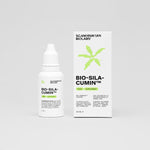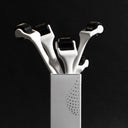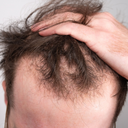Adequate nutrient intake and absorption are not only vital for sustaining our overall health but also play a significant role in the health of our hair [1].
As hair is not an essential body part, it’s not a priority when it comes to nutrient delivery, and only gets nutrients once the needs of other, more vital organs have been met. That’s why any nutrient deficiency is likely to show first in our hair and nails. All that is to say that sufficient nutrient intake is absolutely necessary to maintain healthy and vital hair.
Nutrients are mainly obtained from diet. However, in some cases dietary nutrients may not be enough for body’s requirements. That’s when supplementation with different nutrients, including vitamins and minerals, is usually recommended. However, it cannot replace dietary nutrition [2,3].
Although supplements are widely used, not all are absorbed equally well by our bodies. In fact, processes of nutrient absorption are quite complex and there are several factors that can influence them.
While supplements are convenient, nutrients from whole foods are generally better absorbed due to their natural form and the presence of complementary compounds that aid their absorption. That said, the right supplementation can still play an important role in meeting specific nutrient needs when they can’t be met by our diet.
We will briefly discuss it in this article.
Table of content
The science behind nutrient absorption
The process of nutrient absorption is quite complex and involves the uptake of nutrients from the digestive tract into the bloodstream, where they are then transported to various tissues and organs throughout the body.
This process primarily occurs in the small intestine. In fact, most of the nutrient absorption takes place there [4].
Ingestion
The process of nutrient absorption begins with the ingestion of food and beverages containing nutrients. Ingested food/beverage is then broken down into smaller particles during process of digestion, allowing for easier absorption.
Digestion
In the stomach, food is mixed with acidic gastric juice, which contains hydrochloric acid and enzymes that break down macronutrients (carbohydrates, proteins, and fats) into smaller molecules.
In the small intestine, further digestion process occurs thanks to pancreatic enzymes and bile from the liver. During this step, carbohydrates are broken down into sugars, proteins into amino acids, and fats are broken down into fatty acids and glycerol.
Absorption in the small intestine
As previously mentioned, nutrient absorption primarily occurs in the lining of the small intestine, which is lined with specialised cells named enterocytes. Furthermore, the small intestine has a large surface area for absorption due to its folds, villi (finger-like projections), and microvilli (tiny hair-like structures) that increase its surface area.
Different nutrients are absorbed through specific mechanisms [5]:
- Carbohydrates: Monosaccharides such as glucose, fructose, and galactose are absorbed through active transport or facilitated diffusion into enterocytes in small intestine.
- Proteins: Amino acids and small peptides are also absorbed in small intestine into enterocytes either through active transport or facilitated diffusion.
- Fats: Fatty acids and monoglycerides are absorbed into enterocytes by passive diffusion and then, they are reassembled into triglycerides before being packaged into chylomicrons for transport.
- Vitamins and minerals: As for the vitamins and minerals, they are absorbed by different mechanisms, depending on the specific nutrient. The processes include passive diffusion, active transport, and facilitated diffusion.
Transport into the bloodstream
Once nutrients are absorbed into enterocytes, they are transported across the epithelial cells into the bloodstream [5].
Water-soluble nutrients such as carbohydrates, proteins, and water-soluble vitamins enter the bloodstream directly through capillaries in the villi of the small intestine [6]. On the other side, fat-soluble nutrients and larger molecules like chylomicrons (containing dietary fats) first enter the lymphatic system, before being transported into the bloodstream.
Transport to tissues and organs
Once in the bloodstream, nutrients are transported throughout the body, to various tissues and organs, where they are utilized for energy production, tissue repair, growth, and other physiological processes [7].
Excretion
Any unabsorbed nutrients, or waste products from digestion and metabolism, are excreted from the organism through the feces or urine. Excretion rates depend on the vitamin itself.
As your leading source for hair health information over the past 4 years, we never compromise on accuracy. When it comes to your health, you deserve information you can truly rely on - and earning your trust is our top priority.
Here's how Scandinavian Biolabs ensures every piece of content meets the highest standards of accuracy and integrity:
- Credentialed Experts: Our reviewers are actively practicing doctors and medical researchers
- Stringent Reviews: Content undergoes rigorous editing by subject specialists and review by a practicing doctor.
- Evidence-Based: We rely on well-established research from trusted scientific sources like peer-reviewed journals and health authorities.
- Full Transparency: Our editorial standards, writer credentials, reviewer credentials, correction process, and funding are all publicly documented.
- Independent Voice: While we do promote products, we operate in a vacuum to business operations. Our main goal is just an unwavering commitment to providing medically-sound guidance.
You can count on Scandinavian Biolabs to consistently deliver the trustworthy health information you deserve. Read our Editorial Standards.
Factors influencing nutrient absorption
Bioavailability
Bioavailability refers to the proportion of a specific nutrient that is absorbed and utilized by the body. The bioavailability of an ingested nutrient that is made available (delivered to the bloodstream) for its intended mode of action is more relevant than the total amount present in the original food. Several factors influence the bioavailability, including the chemical form of the nutrient and its interactions with other compounds [8].
Nutrient pairing
Combining certain nutrients can enhance each other's absorption, so it is advised to consume them together. For example, pairing iron and vitamin C can significantly boost iron absorption [9], while combining vitamin D and calcium promotes better calcium uptake [10].
Nutrient interference
Just like combining certain nutrients can enhance each other’s absorption, some nutrients or compounds can inhibit the absorption of others. For example, substances like phytates and oxalates found in certain plant foods can bind to minerals including calcium and iron, reducing their absorption, while long-term and excessive intake of zinc can lead to copper deficiency [11].
Overall digestive system health
The general health of the digestive system may significantly influence nutrient absorption. Factors such as stomach acid production, gut lining integrity, gut bacteria balance, the presence of digestive enzymes, or some gastrointestinal diseases, can all play crucial roles in ensuring optimal nutrient absorption. Eating a healthy, balanced diet and avoiding stress can contribute to an ideal digestive environment where nutrients are absorbed more efficiently.
The form of the supplement
Supplements may come in various forms, including tablets, capsules, liquids, and powders – and absorption rates and bioavailability are thought to be different for different supplement forms. This depends on several factors, including dissolution and disintegration properties. However, more research is needed to understand how our body absorbs different vitamin supplements.

How to support nutrient absorption
Given the complexity of nutrient absorption processes, it's not uncommon that nutrient absorption is often disrupted.
First of all, prioritizing a balanced diet rich in a variety of nutrient-dense whole foods to maximize nutrient absorption is key. As stated before, body absorbs nutrients from food easier than from nutrients.
However, if you opt for supplements, choose high-quality products from reputable brands, preferably with third-party testing to ensure purity and potency. Furthermore, consult a medical professional, for advice on which supplements to take and in which doses.
It is also recommended to seek medical advice if you suspect any issues with absorption or nutrient deficiency.
Conclusion
Understanding how the body absorbs nutrients is important for maintaining overall health and supporting the health of our skin and hair, as well. By considering factors such as bioavailability, nutrient pairing, avoiding their interference, and improving digestive system health, we can optimize nutrient absorption for better well-being.
Note once again that a balanced diet supplemented with high-quality nutrients and supplements that aid nutrient absorption from food, can help us unlock the full potential of our body's nutrient absorption capabilities.
However, you should always consult with a healthcare professional for personalized advice on optimizing nutrient absorption and promoting overall health.
References:
[1] DiBaise M, Tarleton SM. Hair, Nails, and Skin: Differentiating Cutaneous Manifestations of Micronutrient Deficiency. Nutr Clin Pract. 2019 Aug;34(4):490-503. doi: 10.1002/ncp.10321. Epub 2019 May 29. PMID: 31144371.
[2] Hu FB. Nutrient supplementation no substitute for healthy diets. Nat Rev Cardiol. 2019 Feb;16(2):77-79. doi: 10.1038/s41569-018-0143-4. PMID: 30573761.
[3] Larson-Meyer DE, Woolf K, Burke L. Assessment of Nutrient Status in Athletes and the Need for Supplementation. Int J Sport Nutr Exerc Metab. 2018 Mar 1;28(2):139-158. doi: 10.1123/ijsnem.2017-0338. Epub 2018 Mar 20. PMID: 29252049.
[4] Wang Y, Song W, Wang J, Wang T, Xiong X, Qi Z, Fu W, Yang X, Chen YG. Single-cell transcriptome analysis reveals differential nutrient absorption functions in human intestine. J Exp Med. 2020 Feb 3;217(2):e20191130. doi: 10.1084/jem.20191130. PMID: 31753849; PMCID: PMC7041720.
[5] Ling CM, Bandsma RHJ. 1.4.4 Gastrointestinal Development, Nutrient Digestion and Absorption. World Rev Nutr Diet. 2022;124:101-106. doi: 10.1159/000516717. Epub 2022 Mar 3. PMID: 35240617.
[6] Said HM. Intestinal absorption of water-soluble vitamins in health and disease. Biochem J. 2011 Aug 1;437(3):357-72. doi: 10.1042/BJ20110326. PMID: 21749321; PMCID: PMC4049159.
[7] Kiela PR, Ghishan FK. Physiology of Intestinal Absorption and Secretion. Best Pract Res Clin Gastroenterol. 2016 Apr;30(2):145-59. doi: 10.1016/j.bpg.2016.02.007. Epub 2016 Feb 10. PMID: 27086882; PMCID: PMC4956471.
[8] Parada J, Aguilera JM. Food microstructure affects the bioavailability of several nutrients. J Food Sci. 2007 Mar;72(2):R21-32. doi: 10.1111/j.1750-3841.2007.00274.x. PMID: 17995848.
[9] Loganathan V, Bharathi A, Prince AM, Ramakrishnan J. Treatment efficacy of vitamin C or ascorbate given as co-intervention with iron for anemia - A systematic review and meta-analysis of experimental studies. Clin Nutr ESPEN. 2023 Oct;57:459-468. doi: 10.1016/j.clnesp.2023.07.081. Epub 2023 Jul 27. PMID: 37739692.
[10] Khazai N, Judd SE, Tangpricha V. Calcium and vitamin D: skeletal and extraskeletal health. Curr Rheumatol Rep. 2008 Apr;10(2):110-7. doi: 10.1007/s11926-008-0020-y. PMID: 18460265; PMCID: PMC2669834.
[11] Prasad AS, Halsted JA, Nadimi M. Syndrome of iron deficiency anemia, hepatosplenomegaly, hypogonadism, dwarfism and geophagia. Am J Med. 1961;31:532-546.





